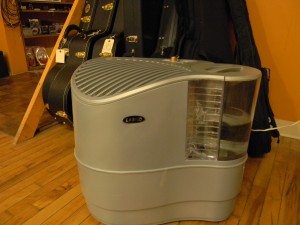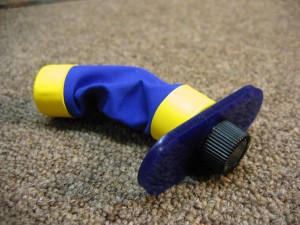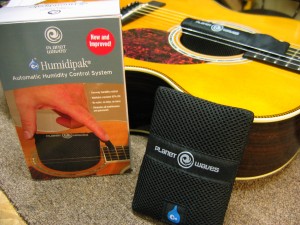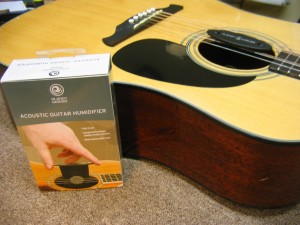“An ounce of prevention beats a pound of cure.” In this post, we’ll break down the best way to protect your guitar in the cool months ahead.
Chicago winters kill guitars. The weather gets dry and cold, so we turn on our furnaces – drying out the air in our homes even further. Many will see their indoor relative humidity drop below 20% . That’s 25-30% lower than the factories where guitars are made and the wood just doesn’t like it. Like the skin on our fingertips and the seams on our hardwood floors, dry guitars can split open without ever being dropped or otherwise mishandled. Other symptoms we see include:
- rough fret ends that stick out past the edge of a fretboard
- loose bridges and braces
- loose neck joints
- separations along the many glue joints that hold a guitar together
- dramatic changes in playing ‘action’
So what can you do to prevent costly repairs to these problems? There’s so many choices hanging in guitar stores that it can be hard to tell which one to buy. Here’s a look at the products that will best help you keep your guitar healthy and happy this winter. You’ll also find a simple formula for how to effectively use them.
We’ve heard some interesting home remedies over the 15 or so years we’ve been working on guitars – from leaving a baggie with a wet sponge in a guitar case to putting an apple or potato inside a case (NOT recommended by this shop!) And we’ve seen lots of products too -from film canister size humidifiers with clay inside to rubber tubes with a sponge inside to space-age devices that can offer protection for months. We’re always looking for answers to this problem and as of 2013, this is our prescription for keeping your guitar properly humidified:
1. Use a good sized room humidifier

We’ are of the opinion that case humidifiers are not enough for many guitars. Create an environment that is healthier for you and your guitar by humidifying your home or at least the room where your guitars live. We’ve grown fond of the Lasko humidifiers like the one above because they hold lots of water – enough for a couple of days at least. 40-50% is ideal, but if you can keep the room’s relative humidity over 30%, you will sleep and breathe better, and your guitar-case humidifiers will be able to do the rest. So how do I know if it’s over 30% then, you ask. A digital hygrometer placed near the case will tell you.

2. Use a guitar case humidifier. Below are our favorites.
First Choice for Acoustic Guitars – Oasis

($20) We really like these humidifiers. They hold enough distilled water to last from one to two weeks without needing to be refilled. Special crystals inside expand into a super absorbent paste that should be replaced each year (replacement kits are available at CFW for $6.) One advantage Oasis holds over every other product is that it will tell you when it’s time to refill by collapsing into a raisin-like appearance that says “Yo! Gettin’ a little dry over here!”

Runner-up Choice for Guitars: Planet Waves Humidipak*

($30) When used with a room humidifier, the Humidipak is a great product that will keep a constant level of humidity inside your case. Three removable packets hang in black mesh pockets (two for the soundhole and one for behind the headstock,) releasing just enough moisture to keep the inside of your guitar case at a comfortable 48% for up to 3 months. Because there is moisture is all in those packets, there’s no need for constant refilling with water. We do have a couple of concerns about the Humidipak, however. First, it cannot do all of the “heavy lifting” when it comes to humidifying the guitar. If the room it lives in is a dry one, it’s going to work much harder and those packets will dry up within a month. Second, while there’s no refilling a water reservoir every week, the packets need to be replaced when they dry out and the cost is about $20 for three. We strongly recommend that it be used in conjunction with a regularly maintained furnace or room humidifier. Read more about it at www.planetwaves.com . While you’re there, be sure to check out the video of Bob Taylor from Taylor Guitars to see what he thinks.
For the tight budget – Planet Waves Humidifier

($8) If you play your guitar every day or two and don’t mind refilling a sponge that often, Planet Waves’ original guitar humidifier is the least expensive option. It’ll work as well as the others but will need more attention.
Humidifying F-hole guitars – Humitron/Dampit tube

($8) Finally, we do keep a few of the old-style tube humidifiers for guitars and mandolins that have F-holes or for those who just like this style. Fill them up every one to two days.
The Recipe For Keeping A Guitar Properly Humidified:
- A FULL humidifer
- Inside the guitar
- Inside the case (NOT hanging on the wall or on a stand.)
- From October through April (or as long as the heat is on in your home)
…Or ignore this advice and come see us in the spring for the best structural repairs anywhere!

I had a problem in the past with Over-Humidifying a guitar. I have a Collings D-1A that I put an Oasis humidifier in and also use a room humidifier. It was kept in a very air tight Price fiberglass flight case. I hadn’t checked the guitar in a few weeks and when I did, I discovered a fine powdery mildew on the surface of the guitar and in the case. The guitar top had also swelled and bulged so much that the action was high and unplayable. I thought the neck needed resetting till I ran a straight edge over the guitar top and discovered the swelling. After calling Collings and talking to a company person, I found out it was over humidified and needed to dry out. He said Collings has done research and recommended 30% humidity is enough for most guitars. After all, Austin Texas, the home of Collings guitars, is a dry place. He said drastic changes in humidity is more of a problem. Also the guitar case was air tight and air couldn’t circulate through it. After letting it sit in an open room for 3 weeks, the action went back to normal. It took about 6 weeks for the tone to come back though.
Dave,
It’s definitely possible to over-humidify a guitar. Without knowing where you live or what time of year this was, I’ll say that I can’t remember more than a couple of guitars coming into our shop in Chicago with that problem in the last 15 years. Collings makes some incredible guitars and I suspect that the fact that they are built in dry Texas does them a huge favor. The wood is dry on it’s on terms when the guitar is built – something lots of builders simulate by kiln-drying the wood ahead of assembly. When a guitar is built dry, it has less moisture to lose, so it’s more stable when it’s exposed to dry conditions. Of course, the flip-side to this would be that there’s not as much room in the wood’s cells to absorb excess humidity – possibly leading to over-swelling and mildew problems (also bearing in mind that “flat-top guitars are generally not flat – but have a loaded, radiused top.) I’ve heard that older, pre-climate-controlled-factory Martins vary greatly based on the time of year they were built. Winter guitars were built under drier conditions and hold up much better over the years. Of course, guitars of that era were built with much older-growth timber than most modern guitars too.
A couple of case studies; we have a guitar in the shop right now that was built in Bogata Colombia where the dry season is close to 60%RH and the wet season is close to 100%. We’re repairing 8 top cracks in that guitar. Then, I have an acoustic I made in guitar-building school summer of 2000 in Michigan that requires almost no humidifying (something I was relieved to discover after neglecting it!) I adjusted the truss rod ONCE 3 or 4 years ago and have never seen any effects of dryness apart from some rough fret ends. We kiln-dried our woods there and I think that made a huge difference. I suspect the kiln-drying process is either hurried or altogether skipped in lots of factories because it’s almost always newer guitars that we see splitting and having problems. Want to have your mind blown? Look at the serial numbers for Martins (and use them as one example of what’s happening in the larger guitar manufacturing world.) Their numbers are sequential dating back to the late 1800’s. See how long it took them to get to #250000 guitars; then #500000, then #1000000. Can production expand that much without costing something in the quality control department?
So yes, especially in the case of a finely made acoustic – consult the manufacturer for instructions. They may have a recommended humidity level based on their experience with their own guitars. We’ll never declare our knowledge of wood and humidity complete, but this article is based on seeing thousands of guitars in our home town. Best of luck!
Great advice guys. Live in Edmonton, Alberta, Canada and in our winters indoor humidity can down to 15% without room humidifiers. All my guitars are kept in wood guitar cabinets in our finished basement and the acoustics all get Planet Waves that I refill every week. Cabinets maintain a 35-40% range.When I build it is in a regulated 25-30% shop.